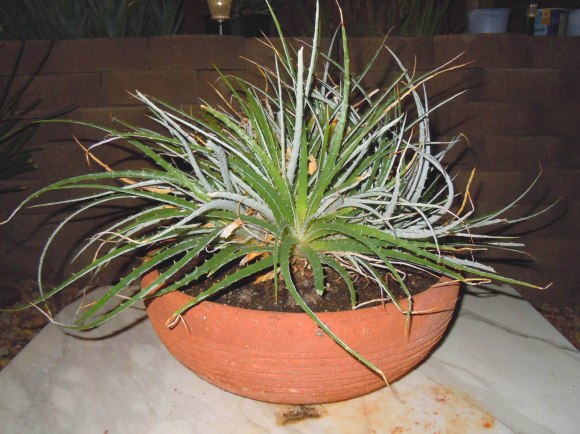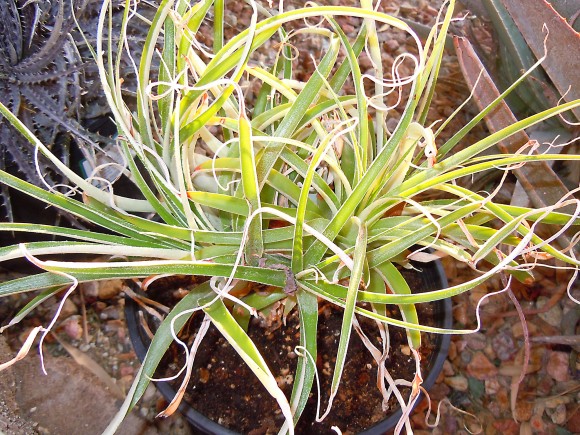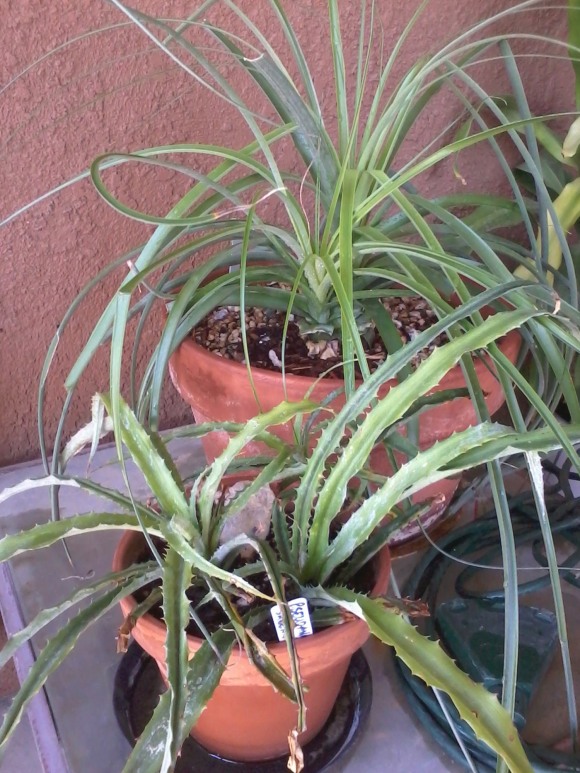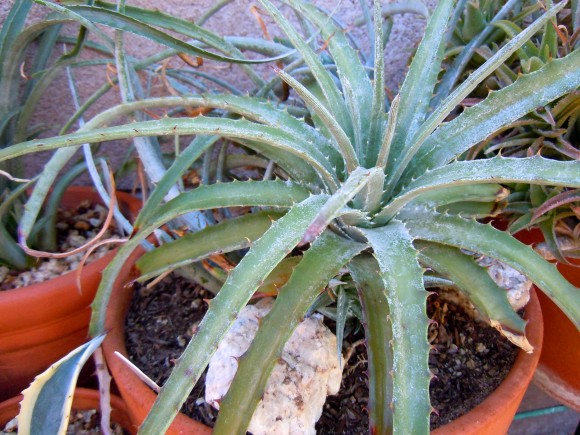Hechtia montana
Hechtia tillansioides
Hechtia lundelliorum (rear) and Pseudoananas sagenarius in foreground (False Pineapple)
First picture: This particular clone of Hechtia montana (now a clump!) I obtained from Dutch Vandervort almost 10 years ago. It has matured very nicely, although it hasn’t bloomed for me yet. Dutch told me the Hechtia montana he sees around in Mexico look quite different from this guy—growing conditions and spontaneous mutations in particular clones can vary the appearances of plants of the same species.
Hechtia is a genus with about 50 or so species and a few hybrids of evergreen terrestrial Bromeliads. Most Hechtia are from Mexico. They are in the family Pitcairniodeae along with Dyckia, Deuterocohnia and Puya. Although I have quite a few Hechtia species in my collection, I have barely scratched the surface of actually collecting them all. Also, new species are being documented all the time—many without proper names, just location markers as to where they were observed and collected. This sure doesn’t help my Bromeliad addiction any!!!
In the third photo above, you’ll notice how much healthier the Hechtia behind the Pseudoananas looks. I’ve had both plants for quite a few years. The False Pineapple plant is a tropical Bromeliad, these plants prefer much more humidity and filtered sunlight. The intense desert sunlight here fries most tropical Broms without some amount of shade. I haven’t had any problems with my Hechtias, either here in Desert Hot Springs or down in Palm Springs, CA. With direct sunlight, filtered sunlight–like under palm trees, or full shade…these guys thrive. The only thing that could hurt these bad boys are poor drainage situations. If keeping these plants in pots, DO NOT use a pot saucer under them as the soil needs to drain completely after watering well. I personally, have never kept a Hechtia indoors as a houseplant—I suppose if you took it outside to water it well, let it drain out fully, then take it back indoors and place it on a drainage saucer, that would work well.
Most species of Hechtia are found in desert/arid regions of Central America: rocky canyons, steep cliff faces, and sandy deserts. They can be seen in the wild growing alongside Agave, Cacti, Yucca and Tillandsias. So why oh WHY are they not used more in Xeriscape planting designs here in the Coachella Valley???!!!! I can’t help but think it is just ignorance that Landscapers and “Weekend Gardeners”, such as myself, don’t use them as a Desert planting staple. My hope is that someone who has a rock garden or Cacti collection might read this and decide to try out some of these great plants alongside old favorites in their own front or backyard. There is really no excuse for not picking some up! With online suppliers listed in the United States from coast to coast, you can have these spiny devils (or spineless–such as H. tillandsioides & H. lundelliorum) delivered to your doorstep within a week. Yuccado.com, Tropiflora.com, Birdrocktropicals.com to name but a few….The sources are almost endless! I will endeavor to create links to all my fave Brom suppliers in the future.
Hechtia Podantha




[…] Hechtia: The Perfect Bromeliad for Desert Landscaping […]
[…] Society/HoustonHechtia” Annie’s Magic Garden “Hechtia texensis” Strange Wonderful Things Hechtia: The Perfect Bromeliad for Desert LandscapingPhoto “Hechtia texensis” courtesy of Stan […]
Are you still maintaining this website? I have a Hechtia tehuacan that I wonder if it’s getting sun burned in full sun. I’m in Northern California and inland.
I am, though I have had very little time to add new posts. It is possible to get sunburned if in direct sun all day. Half-day full sun fine. if air is too dry they require more watering–but make sure drainage is really good. Mine get shade from house in morning and then from rear wall in late afternoon.